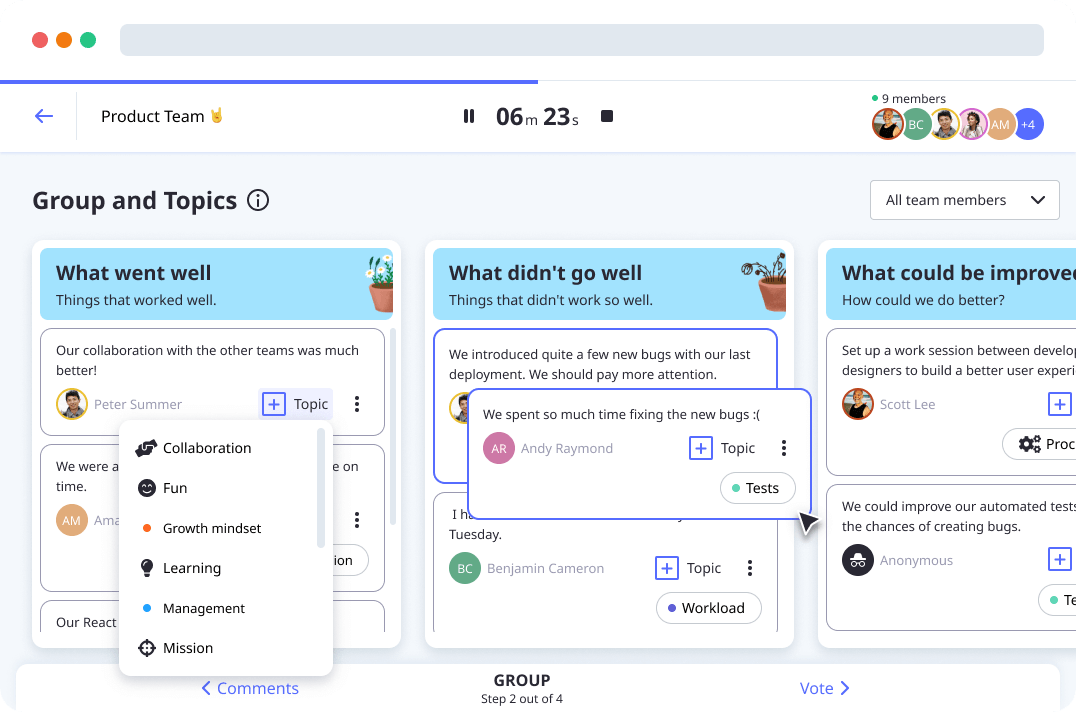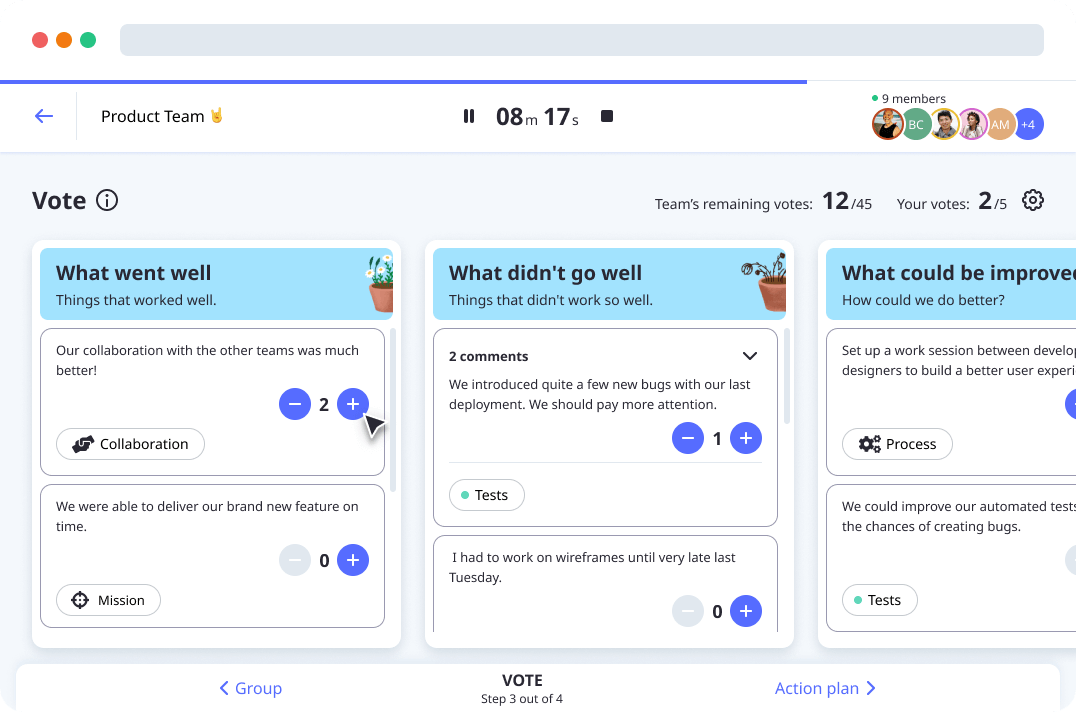Mastering Sprint Retrospectives: The Key for a Successful Scrum Team


The Sprint Retrospective is a cornerstone event of Scrum, aimed at improving how the team creates value. It involves examining the events of the previous Sprint and collaboratively proposing concrete actions to help the team improve quickly.
The Sprint Retrospective echoes the three pillars of Scrum: transparency, inspection, and adaptation.
Transparency is necessary as team members must share the difficulties and learnings of the last Sprint.
Inspection is critical because the goal of a retrospective is to evaluate what happened and determine necessary improvements.
Adaptation is essential as the logical next step after a Sprint Retrospective is to implement these improvements.
In this article, you will discover how Sprint Retrospectives can make your team more effective when used following the values and pillars of Scrum.
Topics covered in this article include:
What is Scrum, its pillars, and its values?
“Scrum is a lightweight framework that helps people, teams and organizations generate value through adaptive solutions for complex problems.”
- Scrum.org
Scrum is based on an incremental and empirical approach, where features are developed in small pieces using iterations called "Sprints." Sprints are of short duration, typically 2-4 weeks, and allow teams to produce tangible results quickly.
The three pillars of Scrum:
Transparency enables team members to understand each member's goals, roles, and responsibilities, as well as the progress of the work.
Inspection allows for regular evaluation of team performance and detection of potential problems.
Adaptation allows teams to adapt to changes and make necessary decisions to achieve goals.
The five values of Scrum:
Courage enables team members to make crucial decisions and commit to achieving goals.
Focus allows team members to concentrate on the most critical tasks to achieve goals.
Openness enables team members to consider new ideas and work together to solve problems.
Respect allows team members to work together professionally and help each other.
Commitment motivates team members to achieve the goals of the team and the company.
What is a Sprint Retrospective?
A Sprint Retrospective is a Scrum event that takes place at the end of each Sprint. This event aims to improve the development process by examining the actions taken during the previous Sprint.
“At regular intervals, the team reflects on how to become more effective, then tunes and adjusts its behavior accordingly.”
- Agile Manifesto
In a retrospective, the Scrum Master ensures that the event is conducted effectively and productively. However, any member of the team can facilitate the exercise.
The Sprint Retrospective is a crucial moment for the Scrum team, as it allows for reflection on the actions taken, identification of improvements to be made, and implementation of those improvements to enhance performance in future Sprints.
It is also a means of strengthening collaboration and communication among team members, which is essential for the success of Scrum.
The Sprint Retrospective is linked to Scrum values and pillars in several ways:
Transparency is ensured by sharing the results and difficulties encountered during the Sprint. Team members describe what was done and what was not done, what worked well and what did not.
Inspection allows for evaluation of the actions taken and determination of improvements to be made. Team members examine their work process and look for ways to optimize their performance.
Adaptation involves implementing these changes to improve performance in future Sprints. Team members collectively decide on actions to undertake to improve their work process.
The value of collaboration is also present at this event, as it allows team members to come together to discuss their actions, problems, and ideas to improve their performance.
The Sprint Retrospective is an iterative event, which is repeated at the end of each Sprint, allowing the team to improve continuously.
Why are retrospectives important in Scrum?
“The Scrum Team identifies the most helpful changes to improve its effectiveness. The most impactful improvements are addressed as soon as possible. They may even be added to the Sprint Backlog for the next Sprint.”
- Scrum Guide
Sprint Retrospectives are essential for several reasons:
Improving team performance: Sprint Retrospectives allow the team to reflect on the actions taken, identify areas for improvement, and implement them to improve the performance of future sprints. This allows the team to self-evaluate and self-improve, which is essential for success.
Strengthening collaboration and communication: Sprint Retrospectives are a means to enhance cooperation and communication between team members. This fosters a better understanding of everyone's tasks and objectives, effective problem-solving, and a culture of trust and mutual respect.
Identifying and resolving problems: Sprint Retrospectives enable the team to discuss difficulties encountered in the previous sprint and find solutions to fix them. This prevents the same issues from arising again and optimizes team performance.
Creating an action plan: Sprint Retrospectives allow the team to define concrete actions to improve their work process and add them to the team's action plan for the next sprint. This ensures that improvements are tracked, and that defined actions are implemented.
Staying aligned with the objectives: Sprint Retrospectives allow the team to remember the objectives and priorities and ensure that they are aligned with the actions taken. This helps the team to continue progressing in the right direction while following the values and pillars of Scrum.
How to conduct a Sprint Retrospective?
Preparation
1 - Decide on the retrospective focus (or not!)
If the Scrum team has data (OKRs, KPIs, metrics), propose or decide on an improvement axis to address during the next retrospective as a team.
You can also use an activity like the team radar to obtain data on your team's health.
Alternatively, the simplest way is to skip this step and let the team choose essential topics during the retrospective.
2 - Choose a retrospective activity
The Sprint Retrospective template will impact the way the team reflects. Therefore, choosing it based on what you want to accomplish during the retrospective is essential.
Neatro has a collection of retrospective templates you can use with your team in just a few clicks.
If you are new to retrospectives, we recommend a simple template like What Went Well which we will use as an example in this article.
3 - Plan the retrospective and invite the team
Now that the focus and retrospective template has been decided, it is time to plan the retrospective. The retrospective should be conducted at the end of each Sprint, so it is relevant to do it after the Sprint Review. However, you can do it at any time that suits your team.
The retrospective should have a limited time so that discussions do not drag on. If you are still wondering how long your retrospective should last, consult our article on the ideal duration of a retro.
The entire team should be present at the retrospective. This includes your Product Owner, Scrum Master, and developers. If other people, like a manager, want to join the retrospective, don't panic; our article on the manager's role in the Sprint Retrospective will help.
💡Tip: With a tool like Neatro, planning a retrospective and inviting your team is very simple. Choose a date for your retrospective, then share a link with your team members. We'll even remind you of the retrospective 24 hours in advance!
Running the Retrospective

Step 1: Break the Ice
For a team to discuss real problems, team members must trust each other. To do so, your team must have a high level of psychological safety.
An icebreaker activity is an excellent introduction to creating bonds between team members and creating a relaxed atmosphere conducive to sharing.
You can use an Icebreaker question list, ask them in turn to team members, and let them discuss and have fun for a few minutes.

Step 2: Collect Ideas
Invite the team to join the retrospective activity, and give them a few minutes to write their ideas in each column of What Went Well.
People mustn't influence each other in this phase. Ensure that reflection is personal and that team members cannot read others' ideas before they are shared.

Step 3: Group Ideas
Once the team has finished posting their ideas, members will present them and provide more context behind each comment. Take advantage of this to group similarities and duplicates.
💡Tip: With a tool like Neatro, easily group comments and assign themes that will help you identify your team's critical issues.

Step 4: Prioritize Ideas
The team can now vote on different ideas to determine which ones to address when developing the action plan.
I recommend dot-voting for this step. It is a simple technique that gives a limited number of votes to each participant, which they can spend on their chosen ideas.
💡Tip: With a tool like Neatro, use dot-voting and ensure that people are not influenced with our voting step!

Step 5: Create an Action Plan
The most important part of the retrospective is the action plan.
With a sorted view of comments by the number of votes, decide which ones are the most important to discuss as a team.
Focus on the two or three most essential comments so that you have only 2 or 3 actions to implement until the next Sprint Retrospective.
If you have fewer actions, you increase the chances that they will not be implemented.
Closing

Using a tool like the ROTI, ask your team to rate and provide comments on the retrospective. This will allow you to gather feedback and continuously improve your retrospectives.
Remember to revisit the action plan with your team at the beginning of your next retro and discuss its results.
Our tips to increase the value of your Sprint Retrospectives
Regularly change activities
It is important to change retrospective templates regularly:
Avoid monotony: Team members may become bored and lose engagement by always using the same retrospective formats. By changing activities, interest and attention can be maintained.
Stimulate creativity: Using different activities, other perspectives on problems and opportunities can be obtained, stimulating creativity and innovation.
Get different insights: Different activities can provide complementary information and various team issues.
Encourage participation from everyone: Some team members may be more comfortable participating in certain activities than others. By changing activities, involvement from all team members can be encouraged.
💡Tip: Discover our collection of ready-to-use retrospective templates in Neatro.
Avoid groupthink
If people replicate the ideas or votes of others, the retrospective will not uncover real issues.
Ensure that people do not see each other's comments during personal reflection phases. Mask the votes of the rest of the team during the voting step.
💡Tip: Our article on groupthink will help you understand what is happening in your team and take action!
Regularly change facilitators
To create variety in retrospective activities, you can also change the person who facilitates.
In addition to approaching the retrospective from a new angle, this will allow the Scrum Master to participate actively in the exercise.
💡Tip: Our guide to conducting a retrospective without a Scrum Master is here to help you.
Follow up on your action plans
An action plan that fails to succeed makes the retrospective a waste of time for the team. Always assign a responsible person to each action and review ongoing actions at the beginning of each retrospective.
This will increase the chances of success and the impact of your action plans.
💡Tip: Neatro automatically reminds you of ongoing actions at the beginning of each retrospective. Try it here and enjoy 30 days free!
Frequently asked questions about Sprint Retrospectives
The Sprint Retrospective is a foundation of continuous improvement in Scrum. Repeating and constantly improving them enables the team to discuss real issues and create actions that will have an impact.
By following the pillars and values of Scrum, your team will increase its level of trust, psychological safety, and the effectiveness of its Sprint Retrospectives.



